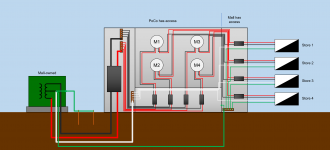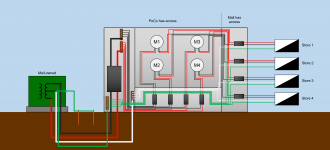I have a question regarding grounding and bonding, in the case of a multi-store mall.
Consider a mall, with a dedicated transformer connected to the primary distribution lines on the HV side (say 13.8 kV). The LV side (say 240/120 V) conductors of the XFMR are then run to a set of cabinets. First, a main breaker (say 600 A) is encountered in a vertical cabinet. Then, the conductors are run to an adjacent horizontal cabinet with two-pole distribution breakers (say 70 A), one for each store. Then, the load-side of those breakers are connected to individual meters in another cabinet, again one for each store. Only the PoCo (power company) has access to the three previous cabinets. Finally, from the meters, conductors are run to another vertical cabinet with also two-pole distribution breakers, again one for each store, but now the mall owner has access to this cabinet; after each distribution breaker in this cabinet, conductors are run to the main panelboard of each store of the mall.
I'd like to know how should the grounding and bonding (only connections) be done in this scenario, in two cases: 1) private transformer (owned by the mall); 2) utility-owned transformer.
For case #1, I suppose that if it the transformer secondary neutral is not connected to the primary neutral, then the transformer is considered a SDS (separately derived system), hence the secondary neutral must be grounded and be bonded to the XFMR enclosure. Downstream of the XFMR enclosure, the neutral and ground wires are kept separate for each store. The main panelboard of each store must have the neutral and ground terminal bars separate. If each store owner want to, they can install more ground rods, connected to the ground (not neutral) terminal bar of their main panel. Is this correct? This is shown below.

For case #2, would the answer be the same? Or would somehow the main panel of each store receive the two hots plus neutral with no ground wire, and then require to bond and ground their neutral (for each store)?
Consider a mall, with a dedicated transformer connected to the primary distribution lines on the HV side (say 13.8 kV). The LV side (say 240/120 V) conductors of the XFMR are then run to a set of cabinets. First, a main breaker (say 600 A) is encountered in a vertical cabinet. Then, the conductors are run to an adjacent horizontal cabinet with two-pole distribution breakers (say 70 A), one for each store. Then, the load-side of those breakers are connected to individual meters in another cabinet, again one for each store. Only the PoCo (power company) has access to the three previous cabinets. Finally, from the meters, conductors are run to another vertical cabinet with also two-pole distribution breakers, again one for each store, but now the mall owner has access to this cabinet; after each distribution breaker in this cabinet, conductors are run to the main panelboard of each store of the mall.
I'd like to know how should the grounding and bonding (only connections) be done in this scenario, in two cases: 1) private transformer (owned by the mall); 2) utility-owned transformer.
For case #1, I suppose that if it the transformer secondary neutral is not connected to the primary neutral, then the transformer is considered a SDS (separately derived system), hence the secondary neutral must be grounded and be bonded to the XFMR enclosure. Downstream of the XFMR enclosure, the neutral and ground wires are kept separate for each store. The main panelboard of each store must have the neutral and ground terminal bars separate. If each store owner want to, they can install more ground rods, connected to the ground (not neutral) terminal bar of their main panel. Is this correct? This is shown below.

For case #2, would the answer be the same? Or would somehow the main panel of each store receive the two hots plus neutral with no ground wire, and then require to bond and ground their neutral (for each store)?



